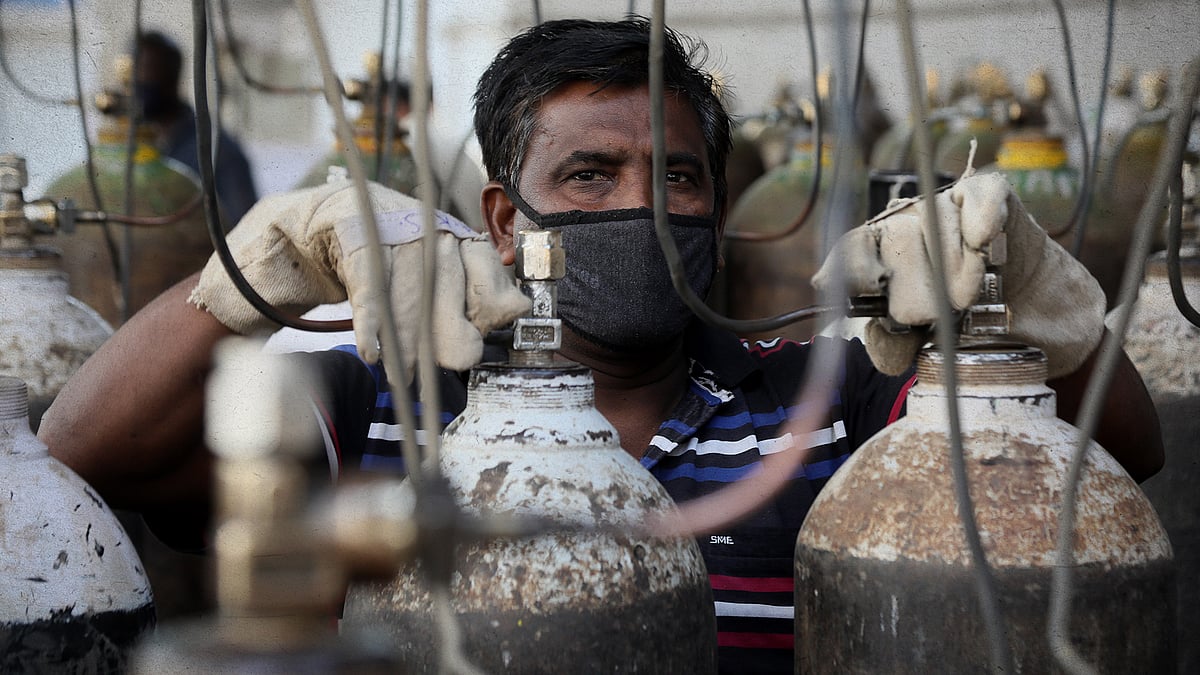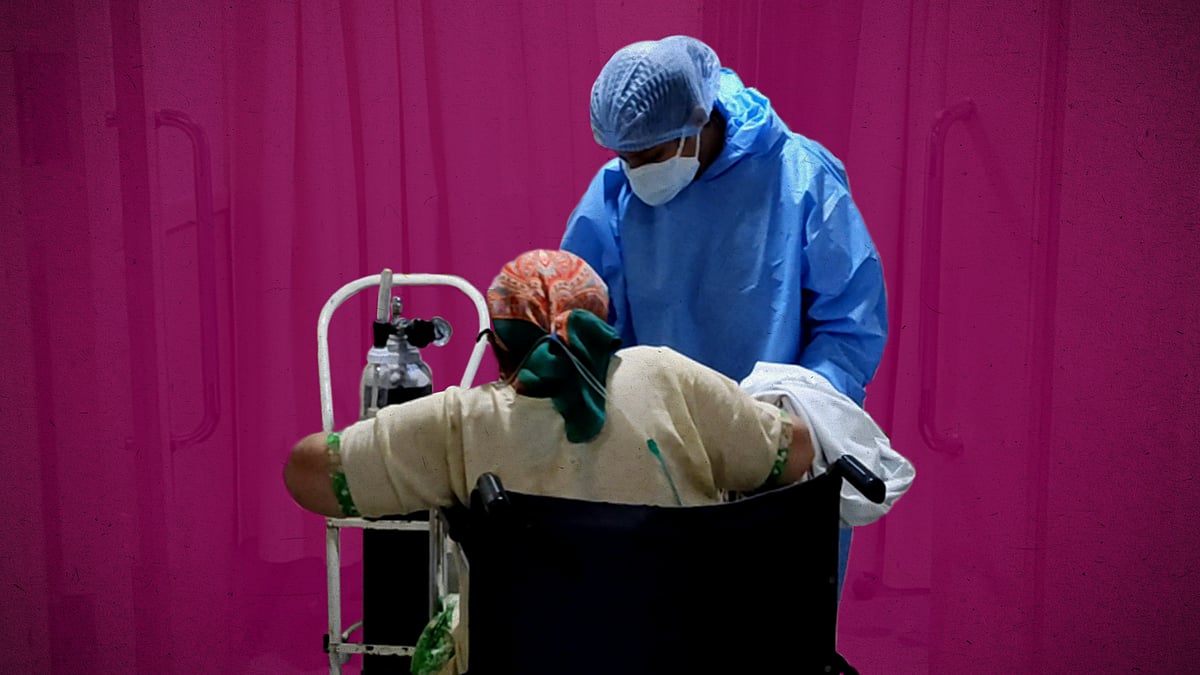How much oxygen is Delhi getting by Oxygen Express?
Did the central government start sending special trains to Delhi only after being pulled up by the courts? The data says yes.
Hospitals across India’s capital are reporting shortage of oxygen because state and central governments didn’t prepare for the second wave of the pandemic. Now that Delhi’s Covid patients are struggling to breathe and governments are scrambling to supply oxygen, it turns out that transporting the life-saving gas is a difficult task.
Oxygen is transported in liquid form in cryogenic tankers. Only a few places in the country produce it in bulk and transporting it to a city like Delhi can be a logistical nightmare.
Currently, the Delhi government’s demand for oxygen is 976 metric tonnes, or MT. According to the official bulletin, the city received an average of 44 percent of its demand until May 4. On May 4, specifically, the government said it received the highest supply till date of 555 MT.
This was followed by Delhi receiving 730 MT on May 5.

The supply was increased only after the courts pulled up the central government for not doing enough for Delhi.
We’ll get to that later.
National requirement
First, let’s look at some national figures. India’s total daily production of oxygen is 7,127 metric tonnes.
On April 18, the central government prohibited manufacturers from supplying oxygen for non-medical use but exempted nine industries – ampoules and vials, pharmaceuticals, steel plants, petroleum refineries, nuclear energy facilities, oxygen cylinder manufacturers, waste-water treatment plants, food and water purification.
These are all process industries that require uninterrupted operation of furnaces. They use around 2,500 metric tonnes of oxygen, according to an official at the Petroleum and Explosives Safety Organisation. This leaves just over 4,600 metric tonnes for medical use.
On April 21, a central government official told the Delhi High Court that the daily demand for medical oxygen in the country had risen to 8,000 metric tonnes. Even if the 50,000 tons of oxygen reserve are utilised to meet the current demand, that would cover barely two weeks of need.
To mitigate this dire situation, the ministry of railways launched special trains, called the Oxygen Express, on April 24 to augment the supply of oxygen to the capital.
How is it going?
We accessed the railways ministry’s live tracking dashboard to analyse the movement of trains from April 24 to May 5, focussing on trains arriving in Delhi. Here is what we found.
This is an analysis of only liquid oxygen being transported to Delhi by rail. It does not include transport of oxygen by road and air.
How much oxygen is coming?
Between April 24 and May 5, a total of 2,434 MT of oxygen was transported using trains across India, out of which 810 MT came to Delhi as of yesterday. Delhi, therefore, received a third of the total supply.
Uttar Pradesh and Madhya Pradesh received 29.2 percent and 12.3 percent, respectively. Delhi showed a daily increase of 20,960 coronavirus infections on May 5; Uttar Pradesh and Madhya Pradesh recorded 31,111 and 12,319, respectively.

But the picture was very different until May 4.
From April 27 to May 3, Delhi received 198 MT of oxygen by three trains. In the same period, 20 trains supplied 1,104 MT of oxygen nationally. The bulk of Delhi’s supply arrived on May 4 and 5, when it received 612 MT of oxygen by six trains.

In comparison, Uttar Pradesh received 468 MT of oxygen in the same period by 10 trains.

What might have caused a sudden spike in supply to the capital on May 4? The Delhi High Court had pointed out that it was the responsibility of the central government to provide 700 MT of oxygen to Delhi. If it failed to do so, the court added, the government officials responsible would be held in contempt of court.
The Supreme Court stayed that order yesterday but emphasised that the central government should increase the supply of oxygen to Delhi to meet the previous demand of 700 MT.

The judicial push seems to have worked. On May 6, as of writing this report, 102 MT of oxygen has reached Delhi. It was 158 MT on May 5. An additional 206 MT is in transit. It is expected to reach Delhi on May 6-7.
A small detail here: some Oxygen Express trains are stopping in Faridabad, Haryana, and there are reports that some of the oxygen unloaded there is then supplied to Delhi. Between May 1 and 4, at least 207 MT of supply was unloaded at Faridabad. On May 5, another train arrived in Faridabad carrying 163 MT of medical oxygen.
It’s unclear how much of this went to Delhi, and how much went to Haryana.
Where is the supply coming from?
Trains supplying Delhi have so far originated in four states – Bengal, Chhattisgarh, Gujarat and Odisha. Three trains have come from Bengal, three from Gujarat, two from Odisha, and one from Chhattisgarh.
Quantity-wise, most of Delhi’s supply has come from Odisha, 232 MT in total, followed by Gujarat at 225 MT. Bengal has supplied 180 MT and Chhattisgarh 70 MT of liquid oxygen.

If you check at national data, Jharkhand is the top supplier of oxygen, having sent 38 percent of all liquid oxygen transported by train. Till date, it has supplied 928 MT of oxygen. Jharkhand is also one of the states to have sent oxygen to Delhi by road.

Observations
The data tells us that the oxygen heading to Delhi by train increased after the courts pulled up the Modi government. But it remains to be seen if this supply stays consistent. On May 4, Delhi received 555 MT, according to its bulletin, of which 466 MT was clearly by rail. The remaining 86 MT would have been by air or road.
Meanwhile, the daily demand for oxygen in Delhi has gone up from 700 MT to 976 MT, but the supply continues to be inadequate. The central government has contested this requirement, saying its an overestimation and that Delhi requires only 415.43 MT of oxygen.
With research inputs from Dhyanesh Vaishnav.
 ‘We lost so horribly’: Batra Hospital sees eight patients die as oxygen runs out
‘We lost so horribly’: Batra Hospital sees eight patients die as oxygen runs out Watch: Why doesn't Delhi have enough oxygen?
Watch: Why doesn't Delhi have enough oxygen?